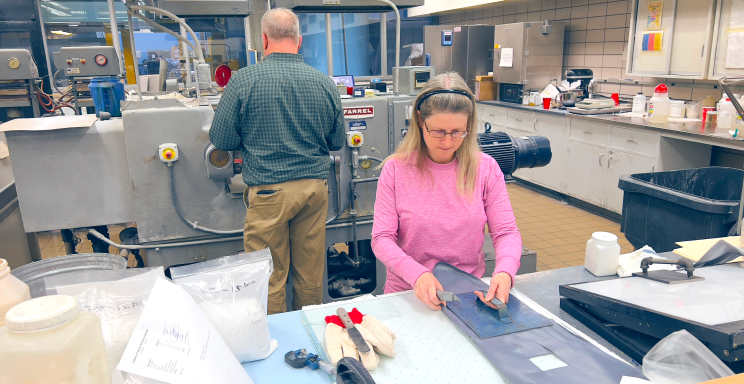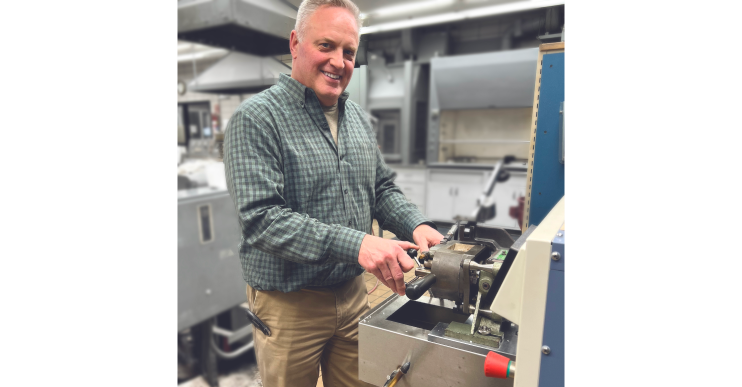“I’d love to engage other businesses in our industrial park. I believe that a rising tide raises all boats, and if we can work together with other manufacturers to reduce the barriers to beginning a career in manufacturing and growing the overall pool of talent, we will have a tremendous impact on trade, industry and our community.”
– Alex Grover, CEO, i2M
Background: Child Care Disruptions Affect Operations and Retention
Proudly based in Mountain Top, Pennsylvania (pop 11,856), i2M manufactures, designs and prints advanced plastic films used in everything from tents to faux stone shower tiles and prides itself on leading with purpose. According to chief executive officer Alex Grover, i2M exists to “disrupt the plastics industry” and is committed to building a sustainable future in plastics by focusing on people, products and processes. And people always come first.
“My passion is helping our team build great careers in manufacturing and making these careers accessible to everyone, including women,” Grover said.
As a woman leading in a traditionally male-dominated industry, Grover recognizes the added workforce barriers women face. Likewise, she understands the costs to productivity and profit when employees can’t make it to their scheduled shifts. So when internal data showed a rise in missed or canceled shifts and hiring slowdowns, i2M dug deeper to understand the root causes. “Our team is the foundation of our success,” said Grover. “When call-offs started trending up and new-hire numbers dropped, we knew something had to change.”
Solutions: Data and Strategic Partnership Guide Targeted Action
Needs Assessment Identifies Child Care Gaps
i2M conducted a needs assessment to understand what support employees needed most. Results pointed to two critical challenges: child care and transportation. More specifically, many team members were struggling to find child care options that aligned with i2M’s 12-hour shifts — especially during early mornings.
For child care, the data also uncovered that the largest age group needing care was preschoolers. But care options for preschool-aged children were limited, with few programs offering the flexibility or hours they needed. Responses also showed that employees wanted access to existing locations across town to allow workers to select a child care center in a convenient location for their family. “With this data in hand, we knew who we were looking for,” Grover said. “Shift workers with nontraditional hours need to be able to come to work and feel confident that their kids are cared for.”
A Flexible, Community-Based Model for Child Care
Working with child care provider Building Blocks, another woman-led business in the area, i2M started offering subsidized, extended-hours child care for employees’ kids in January 2022. Building Blocks reserved child care slots from 6 a.m. to 6 p.m. — covering the bulk of i2M’s shifts — and helped apply for grant funding to support operations. It took about six months to implement.
The partnership allows i2M’s team members to be ready to start work at 7 a.m. and have pick-up at the end of the day at a location of their choice for a cost to the employee of $100 per month per child. Building Blocks has five locations and shares i2M’s commitment to quality and school readiness. “Finding the right partner was critical,” Grover said. “They understood our workforce, shared our values and were willing to co-design a solution that worked for us.”
To address the other barrier uncovered in the needs assessment — transportation — i2M partnered with the Institute for Public Policy and Economic Development to provide interest-free loans to i2M team members for car repair or replacement.
Results: Measurable Impact for Families and the Business
By directly addressing the needs they uncovered through employee surveys, i2M has seen strong results, including:
– A 32% year-over-year reduction in workers canceling or missing shifts, known in the industry as call-offs
– Greater employee engagement and productivity
– Increased workforce participation among parents
Leaders have also been able to showcase i2M’s commitment to investing in their culture and team, and they’ve seen the impact on workers’ families, too. “We’ve had team members tell us that their child’s grades or behavior improved, or that both parents could finally return to work,” Grover shared. “These are the wins that matter.”
Challenges: Nontraditional Hours Remain a Hurdle
Despite early success, Grover notes that care during evenings and overnight shifts is still hard to find. While i2M and Building Blocks adjusted child care start times to support 7 a.m. shifts, late-day coverage remains a challenge. “We’re stuck in a cycle,” Grover said. “There’s no demand because no one offers extended hours, but no one offers extended hours because there’s no visible demand. We still have a lot to do.”
Grover’s Advice to Business Leaders
Start with the Right Partner
Grover emphasized the importance of finding a culturally aligned child care partner. “If we had not signed on with a partner with multiple locations, a program of extraordinary quality and the drive to work with us, this would have been much more difficult,” she said. “We were also clear up front about what we could and couldn’t do,” she said. “That clarity built trust on both sides.”
Ask the Right Questions
To find such a partner, Grover recommends touring facilities, learning about current and future provider capacity and clarifying priorities as well as expectations around reserved slots, age ranges, minimum enrollment and fees. “An early concern of mine was that any issues employees experienced with the child care provider would also reflect on i2M. But knowing that we did our due diligence and found a partner that shares our values, I’m confident we can ensure a positive experience for families. Ultimately, the best solutions come from listening to your workforce and working together with your community.”

